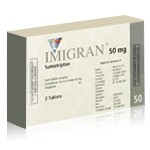Mastering Migraines: From Triggers to Treatment with Imitrex


Migraines are more than just severe headaches — they are complex neurological events that can disrupt daily life, impair productivity, and affect emotional well-being. Characterized by throbbing pain, sensitivity to light and sound, nausea, and sometimes visual disturbances, migraines often require a multifaceted approach to treatment. Modern medicine offers various strategies, from preventive measures to targeted drugs like Imitrex (sumatriptan), aimed at stopping attacks once they start. To understand how to treat migraines effectively, it’s essential to first understand what causes them and how they can be controlled.
Understanding the Nature of Migraines
A migraine is not merely a symptom but a neurological disorder involving abnormal brain activity. This activity affects nerve signals, blood vessels, and chemicals in the brain. The pain often occurs on one side of the head but can shift or affect both sides. Migraines typically last between 4 and 72 hours and are frequently accompanied by nausea, vomiting, and heightened sensitivity to sensory stimuli.
Migraines occur in phases: the prodrome (warning symptoms like fatigue or mood changes), the aura (in some patients, involving flashing lights or visual distortions), the headache itself, and the postdrome (the “migraine hangover,” with tiredness or confusion). Understanding these stages helps patients recognize early signs and intervene before the pain peaks.
What Causes Migraines?
The exact cause of migraines remains incompletely understood, but researchers have identified several interrelated biological and environmental factors. Genetic predisposition plays a significant role; if one parent suffers from migraines, there’s a 50% chance their child will as well. The brainstem and its interaction with the trigeminal nerve — a major pain pathway — appear to be central to the condition. Neurotransmitters, especially serotonin, which helps regulate pain in the nervous system, fluctuate during migraine attacks.
Triggers can vary widely among individuals. Common ones include stress, hormonal changes, sleep disturbances, skipped meals, dehydration, caffeine withdrawal, sensory overload, or specific foods such as aged cheese, chocolate, and processed meats containing nitrates. Environmental factors like bright lights, strong odors, and sudden weather changes may also provoke an attack. Because triggers are highly individualized, keeping a migraine diary is often recommended to identify patterns and reduce exposure.
The Concept of the “5 C’s” of Migraines
Clinicians sometimes summarize the essential elements of migraine understanding using the “5 C’s,” which represent Cause, Course, Characteristics, Consequences, and Control.
Cause refers to the underlying neurological and vascular dysfunctions, as well as the external triggers that provoke attacks.
Course describes the episodic nature of migraines — periods of normalcy interspersed with debilitating attacks that can last hours or days.
Characteristics encompass the distinctive symptoms: pulsating pain, nausea, photophobia, phonophobia, and sometimes visual aura.
Consequences address the impact on a person’s quality of life, including missed workdays, reduced concentration, emotional stress, and social isolation.
Control represents the overarching goal of treatment: to minimize attack frequency and severity, prevent complications, and empower patients to manage their condition proactively.
Together, these five aspects provide a comprehensive framework for understanding migraines and tailoring effective interventions.
Making a Migraine Go Away
When a migraine strikes, relief becomes the immediate priority. The effectiveness of treatment depends largely on timing — acting early in the attack often leads to better results.
For mild migraines, simple measures can sometimes suffice: resting in a dark, quiet room, applying a cool compress to the forehead, maintaining hydration, and avoiding strong sensory stimuli. Over-the-counter pain relievers such as ibuprofen, naproxen, or acetaminophen may alleviate early-stage pain if taken promptly. However, overuse of such medications can lead to “rebound” or medication-overuse headaches, so they should be used with caution and not more than 10 to 15 days per month.
For moderate to severe attacks, triptans — a class of prescription medications — are the cornerstone of acute migraine treatment. Among them, Imitrex (sumatriptan) is one of the most well-known and effective.
Imitrex works by stimulating serotonin (5-HT1B/1D) receptors in the brain, which constrict dilated blood vessels and block pain pathways. It not only relieves headache pain but also reduces associated symptoms such as nausea and sensitivity to light and sound. Imitrex is most effective when taken early in the attack and is available in multiple forms: tablets, nasal sprays, and subcutaneous injections. The injectable form often provides relief within 10 to 15 minutes — a valuable option for patients experiencing rapid-onset or severe nausea that prevents swallowing pills.
For individuals who cannot take triptans due to cardiovascular conditions, newer medications like gepants (ubrogepant, rimegepant) or ditans (lasmiditan) may offer alternatives. Anti-nausea medications such as metoclopramide can also complement migraine therapy when gastrointestinal symptoms are prominent.
Preventing Future Attacks
While abortive treatments like Imitrex stop migraines once they start, prevention aims to reduce the frequency and severity of attacks. Preventive therapy is typically considered for patients who experience more than four migraine days per month, or when attacks are particularly disabling.
Several classes of drugs are used for prevention: beta-blockers (propranolol, metoprolol), calcium channel blockers (verapamil), certain antidepressants (amitriptyline, venlafaxine), and anticonvulsants (topiramate, valproate). These medications work by stabilizing neural activity and regulating blood vessel tone.
More recently, monoclonal antibodies targeting the CGRP (calcitonin gene-related peptide) pathway — such as erenumab and fremanezumab — have revolutionized migraine prevention. They specifically inhibit a molecule involved in pain transmission during migraine attacks and have shown remarkable efficacy with monthly injections.
In addition to pharmacologic options, lifestyle modifications remain vital. Regular sleep, balanced meals, adequate hydration, stress management, and consistent exercise all contribute to migraine control. Avoiding known triggers, practicing relaxation techniques such as meditation or yoga, and using biofeedback can further reduce attack frequency.
Supporting Someone with Migraines
Migraines can be invisible yet profoundly disabling, making empathy and understanding essential. Supporting a person with migraines requires both emotional and practical measures. When someone experiences an attack, creating a calm, darkened environment and minimizing noise or conversation can make a difference. Offering a cold compress or ensuring they have access to their prescribed medication demonstrates thoughtfulness and care.
Outside of active episodes, listening without judgment and acknowledging the seriousness of their condition is equally important. Many migraine sufferers face skepticism or feel guilt for missing work or social events. Encouragement to maintain regular medical appointments, adhere to treatment plans, and keep track of potential triggers can help them manage their health more effectively.
In the workplace, accommodations such as flexible scheduling, reduced screen brightness, or quiet spaces can prevent migraine escalation. On a broader scale, awareness and education about migraines can help dismantle the misconception that they are “just headaches.”
The Role of Imitrex in Migraine Management
Since its approval in the early 1990s, Imitrex (sumatriptan) has transformed migraine treatment by offering targeted, rapid relief. Before triptans, most therapies merely dulled pain without addressing the underlying neurovascular mechanisms. Imitrex’s ability to modulate serotonin receptors and restore normal vascular tone made it the prototype for a new generation of migraine-specific medications.
When used properly, Imitrex can terminate or significantly reduce migraine symptoms in up to 70% of patients within two hours. It is most effective when taken at the first sign of an attack, particularly before the pain becomes intense. However, it is not a preventive medication and should not be used daily. The typical dosage ranges from 25 to 100 mg for tablets, one spray (20 mg) for nasal use, or 6 mg via injection. If symptoms recur, a second dose may be taken after two hours, not exceeding the maximum daily limit prescribed by a healthcare provider.
Side effects are usually mild and transient, including sensations of warmth, tingling, or pressure in the chest or neck. Because Imitrex constricts blood vessels, it is contraindicated for patients with coronary artery disease, uncontrolled hypertension, or significant vascular disorders. In such cases, physicians may recommend non-vasoconstrictive alternatives like gepants or ditans.
Beyond acute symptom relief, the advent of Imitrex and its successors has reshaped migraine therapy philosophy — emphasizing early, mechanism-based intervention rather than simply enduring the pain. For many patients, it has restored normalcy and reduced the psychological burden associated with unpredictable attacks.
The Holistic Approach: Beyond Medication
While pharmaceuticals remain central to treatment, migraines demand a comprehensive, individualized management strategy. Stress reduction is often underestimated but critical. Cognitive-behavioral therapy (CBT) can help patients recognize and modify stress patterns that trigger attacks. Mindfulness meditation, progressive muscle relaxation, and breathing exercises have demonstrated measurable benefits in reducing attack frequency.
Dietary adjustments, such as limiting processed foods, caffeine, and alcohol, may help prevent migraines. Supplementation with magnesium, riboflavin (vitamin B2), and coenzyme Q10 has shown potential preventive effects in some studies. Additionally, maintaining good posture, especially for people working long hours at computers, can prevent tension that contributes to migraine onset.
For women, hormonal fluctuations often play a key role. Some experience migraines during menstruation, pregnancy, or menopause. In such cases, hormonal therapy under medical supervision — including low-dose estrogen or continuous oral contraceptives — can help stabilize hormone levels and reduce attacks.
Living with Migraines: Empowerment Through Knowledge
Although migraines can feel overwhelming, advances in neuroscience and pharmacology have made them far more manageable than in the past. Early recognition of symptoms, consistent preventive measures, and appropriate use of targeted medications like Imitrex give patients the power to control — rather than be controlled by — their condition.
Migraines remind us of the delicate balance between the brain, body, and environment. Through understanding, medical guidance, and lifestyle adjustments, individuals can not only reduce the frequency of attacks but also reclaim their quality of life. The goal is not merely to make a migraine go away, but to cultivate long-term resilience and confidence in managing this complex, yet conquerable, disorder.
Drug Description Sources: U.S. National Library of Medicine, Drugs.com, WebMD, Mayo Clinic, RxList.
Reviewed and Referenced By:
Dr. Messoud Ashina, MD, PhD Professor of Neurology at Copenhagen University Hospital – Rigshospitalet and Director of the Human Migraine Research Unit. A leading global expert in migraine pathophysiology, with extensive research on neurovascular mechanisms and CGRP-targeted therapies.
Dr. Chia-Chun Chiang, MD Vascular neurologist and headache specialist at Mayo Clinic, Rochester, Minnesota. Focuses on migraine with aura, medication-overuse headache, and innovative treatment strategies including nerve blocks and preventive protocols.
Dr. Rashmi B. Halker Singh, MD Board-certified neurologist at Mayo Clinic in Phoenix, Arizona. Specializes in chronic daily headache and cluster headache, with clinical expertise in women’s health and hormonal influences on migraine disorders.
Dr. Michael A. Moskowitz, MD Professor of Neurology at Massachusetts General Hospital and Harvard Medical School. A pioneer in uncovering the trigeminovascular mechanisms of migraine and a key contributor to the scientific foundation behind triptan and CGRP antagonist therapies.
(Updated at Oct 27 / 2025)

